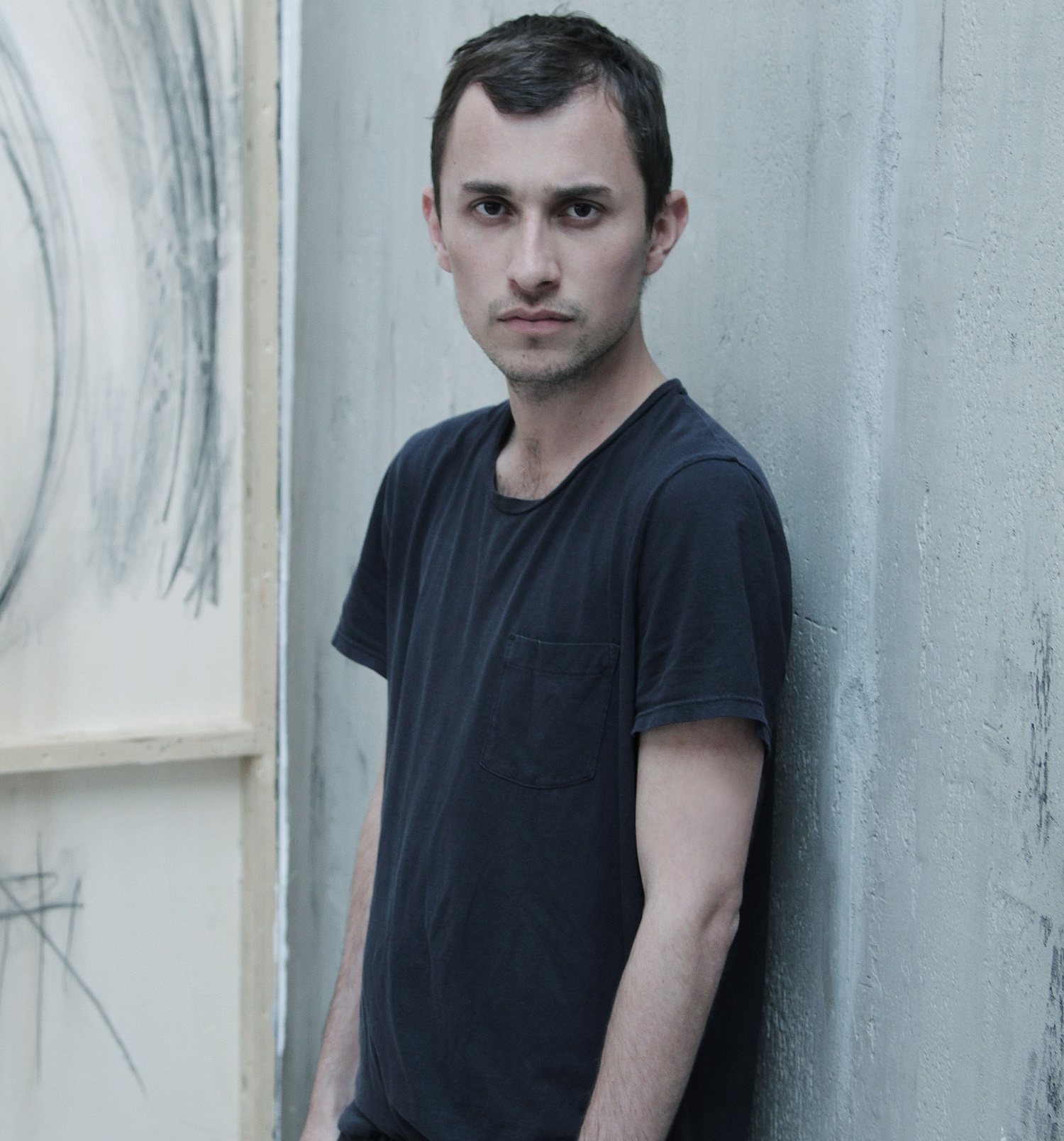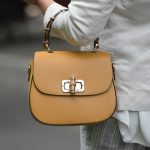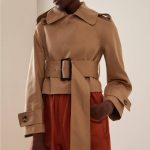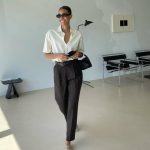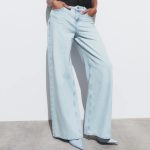You might remember him more recently for leaving Emanuel Ungaro when Lindsay Lohan was appointed, but you’d be wrong to think that’s Esteban Cortazar’s defining moment.
At the ripe age of 26, he’s had his own fashion label, has headed a major French fashion house, has dressed industry insiders and the A-list elite alike, and famously brought Cindy Crawford out of her modelling retirement. And yes, we did say he was only 26.
Born in Colombia but spending much of his childhood in Miami, a 12-year-old Cortazar found himself surrounded by the fast-paced flurry of the city’s style scene and a fashion fascination was born – but little did he know his dream of one day becoming a designer would result in him becoming one of the industry’s biggest success stories.
In 2002, Esteban’s eponymous label made its runway debut to critical acclaim – one year later, he brought Cindy Crawford out of her modelling retirement when she agreed to open and close his spring/summer 2004 show (the pair had formed quite the friendship after eating chocolate covered strawberries together when he was 13, but more on that later), and a further four years on, he would hold the helm at the house of Ungaro.
His love of the feminine form fused with his passion to create cool, intricately-individual pieces had made him a hit with fashion fans across the globe, but like any good story, he’s not without his controversy. Last year, after breathing new life into the classic label, Cortazar hung his creative cap at Ungaro when Lindsay Lohan was brought on board to give the brand publicity – he is, after all, an esteemed designer, and one that probably doesn’t want to be associated with nipple tassels any day of the week.
But fast-forward to today and Esteban has made his catwalk comeback – a collaboration with Colombian high street brand Exito which, though not available this side of South America, has received rave reviews for bringing his high-octane, cool-girl glamour to a commercial level.
He’s a pretty busy guy, as you can imagine, but Mr. Cortazar took time out from his jam-packed design schedule to talk to us about his childhood, Cindy Crawford, his new collection and that Ungaro business…
First of all let’s get the Ungaro gate out of the way – what happened? Why did you decide to leave?
Well I’m sure you read what went on, all I can say about it is that I was quite happy there, it was quite an enjoyable experience and it was an amazing thing for me as a designer, as a person and for my career. And at the start it was incredible, but at the end they wanted to take the company in a direction that didn’t sit right with me and I had to make the difficult decision to leave. But that said there’s really no hard feelings or anything, we decided that it was best to take our separate ways because we just weren’t seeing eye to eye with the direction they wanted to take. And obviously it had to do with Lindsay Lohan and with the strategies they had that I didn’t agree with, but that’s all. It’s pretty simple, actually.
We can’t think of another designer who’s achieved so much at such a young age. How have you done it?
Thank you! You know, every time I get asked a question like that I sometimes don’t really know how to answer because things have happened to me in a very spontaneous way. I’ve worked hard and I had to be very focused when I was very little and I had parents that supported me from the start to do what I wanted to do. I think that really had a lot to do with it, you know, I was free at a very young age to express myself however I wanted to express myself and I think that I got very comfortable with that, very in awe, and began to feel that I wanted to get started with what I wanted to do, which was fashion, right away. From there I was probably in the right environment, the right time, with the right people – well, not probably, I mean I was – and I think that really set the tone with what was going to happen next for me.
Now your parents were very involved in the arts – do you think that instilled some sort of creativity in you from a young age?
Yeah, definitely, being in the arts obviously helped. I grew up around this very bohemian energy and very free energy – I saw my father expressing himself in a very artistic way, I saw my mother express herself in a very artistic way. Their friends were also artists, very bohemian, and that’s what I was around when I was a child, so it was just natural for me to also kind of fall into the same journey. So of course, absolutely, it definitely was a big part of it – and it still is. To know that I have parents like that still inspires me and it’s still great because it’s more like them being my friends than just being my parents.
So how old were you then when you wanted you realised to be a designer?
I think I was probably around 10. It was when I moved to the states to live with my father because my father had been living in the states for a bit and when I decided that fashion was something that I wanted to do, it was around me – it was the envrionment I was in, it was the timing in Miami. When I moved to Miami with my Dad it was a time when Gianni Versace had been building his house there, all the supermodels were coming to Miami and there was a lot of energy within fashion in Miami, there were a lot of photographers coming to shoot and there was just a lot of that environment, so that’s what I was living around and I was really interested in it. And I just spontaneously decided to start, like, making clothes and putting them on my friends at school and making my own fashion shows and that’s kind of how it happened. I was just sort of playing around and then it became something people reacted to and it went from there.
It certainly did. You famously brought Cindy Crawford out of her modelling retirement in your spring/summer 2004 show – that must have been incredible for you.
Yeah, I know, that was incredible. I actually met Cindy for the first time when I was 13 backstage at a Todd Oldham fashion show in New York, which was the first time I went to fashion week, and Todd invited me, and then I met her backstage and I remember we were eating chocolate covered strawberries that they had – and here’s me this 13-year-old little kid so she probably thought that I was cute or whatever, so I’m sort of like sitting on her lap. It’s something you dream about when you’re a kid, when you’re such a young little kid, when you’re so free to express yourself – I don’t think being 40 you can describe sitting on Cindy Crawford’s lap! That’s what was so magical about that time because when I think about it I’m just like, wow, it was so beautiful, but then when that happened it happened in a very natural way, you know, and I think that youth had to do with it. And then the years passed by and I never saw her again, and then I ran into her at an event when I was around 18 or 19, which is when I was starting that show and we saw each other. I reminded her who I was and she totally remembered and then we kept in touch and it just came about – we talked about it and she ended up coming to New York and did the show. And of course for me it was just like, not even a dream come true, I don’t think I ever dreamed of that. I mean it’s too much, you know, it’s something that I never expected in a million years to happen and then it happened and it was really amazing.
So let’s move on to talk about your design work – how would describe your aesthetic? Do you design with a particular woman in mind?
Well I’ve always been very attracted to women that love to be women, that love to get dressed up, to play with clothes and to be feminine and sexy – I grew up around women like that. Obviously I think that has evolved more and more since living in Paris, living in New York, living in Miami – I think I have seen different kinds of women while I have been evolving as a designer. And I think that a mixture between all of the things I have seen and all of the different characteristics that a woman has is what really inspires me at the end, because I love to just sort of mix them – you know, all the different things that a woman can be. But I get my inspiration anywhere, I don’t look for it, it comes to me, and it can come from a book or a movie – I suppose every designer says the same thing, but it is like that for me. It depends on where I am, I could be travelling, but I could also travel somewhere and not necessarily draw inspiration from the place I’ve travelled to. It’s very organic, the process, and it really is dependant – I could see something that triggers me and makes me think,’ok, that’s what I think I should do’, but at the same time it’s a mixture of things. Especially as I’ve been evolving as a designer, I think my mood boards of what I base the collection on is usually a mixture of different things that don’t even have anything to do with each other but they just sort of come together at the end – it’s whatever I see and I like, and I just try to include it somehow.
Having had your own label and being the creative director of a major French fashion house, what would you say the difference is between designing for yourself and for another brand – do you have to compromise your visions at all?
I was pretty lucky that the brand I went to design for was a brand like Ungaro that I felt quite naturally inspired by. Before I went to work there it was the sort of brand that made sense with who I am as a designer; it’s a brand that believes in the type of woman I was just describing to you, who is feminine, who is sexy, who is a bit flamboyant in the way that she dresses, who loves to mix and match, who loves colour – because I’ve always loved colour. I think it was just so easy for me to go in there in that way thinking I feel very connected with the Ungaro woman. And I never really felt like I had to compromise my aesthetic or my feeling for anything, I felt quite right in terms of that. I was doing what I wanted to do, so I’m quite lucky with that, and that gave me so much wisdom and so much knowledge and so much experience to take with me and continue it on into the things I do next.
And the difference between high end and high street? You’ve just designed your first collection for Colombian brand Exito, which we believe is your first commercial line…
Everything happens when it’s supposed to and the circumstance and the audience has to be right. I always wanted to do something in Colombia – it’s my country, it’s where I’m from – and I always wanted to give back to my country. They’ve been so supportive of me since I started in my career and they always wanted to be there for me, but I’ve never actually been able to offer them a collection that they can afford or that they can feel connected to. My collections that I’ve done were always too expensive to bring to Colombia and the amount of people that can actually afford those pieces, they travel abroad to buy them, there really is not a big market in this end. However there’s a huge market of people that have no option for fashion – women don’t know where to buy and there’s such limited amount of stores. I thought if I’m going to do something there it should be something that everybody can access, but at the same time, do something that’s really high in terms of image and really high end in terms of how it’s presented, fabric wise, construction wise, image wise, model wise, everything – and the only thing that was low is the price. And I think that’s a concept that for a country in South America is still very fresh and very new, because in their country they’re not as exposed to fashion as perhaps Paris, London, New York and other cities and countries around the world that are actually really exposed and there’s trillions of options for where you can go and buy great fashion. Over there there isn’t so that’s why for me it makes sense. So I think for me, just to sum it up, as a designer, it’s great to be able to tackle both worlds and be able to be a part of both kinds of markets – I think that once you’re able to do that, you’re sort of set as a designer.
How did the collaboration come about? Did Exito approach you first?
Yeah, actually, I am very good friends with the Consul of Colombia in France, and he actually was the one who had the idea – this is the first time I’ve actually told this story, but I think it’s important to mention him because the more I think about it, I love that it was one of the representatives of Colombia in France who approached me with the idea! And we went to them, and they’d already had me in their mind but they thought I would say no to a collaboration like that. It was just like, they were already thinking about it and then we were thinking about it here and it just was something that was meant to be, so it was perfect. And I loved that there was this whole idea behind it of doing something good for a country, I love that, and I love that it came from the Consul, I thought that was great.
Now Colombia isn’t a country typically renowned for its style, so how does it compare designing for Colombian women as oppposed to Parisian girls?
No, I mean, at the end of the day, women are women – women want to look beautiful, women want to feel comfortable, women want to feel a little bit sexy at times, and that I think is everywhere. But obviously the body types are different, I just had to think of a more voluptuous body or a more curvy body. Girls in Colombia love to show their bodies, so they like short, and they like tight and they like cleavage – they’re like that, they’re Latin girls – but I think it was about introducing new proportions and new ways of making clothes and new ways of matching and mixing and showing a little bit of that personal style, that individual style that we see in London, that we see in Paris, that we see in New York and that we see in other fashion capitals of the world. Where we see real style, because of the exposure and because of the knowledge that there is about fashion – the innate style that you see in certain cities like that. I wanted to bring that international fashion to Colombia for the first time. So I thought about the woman’s body, but I didn’t want to make it all about that because I’d probably be giving them what they already have, and I wanted t give them something new, if that makes sense.
Completely. We have to say we’re a bit gutted we can’t get our hands on it over here because we’ve seen snippets and it looks fantastic.
Thank you so much. I’ve been so surprised by the reaction it’s got because I never even thought that it would be written about, I mean to be honest with you, I found it funny that I started to see so many people reacting to it and writing bout it and wanting it, so it’s been very surprising and I’m very excited about it.
Can you tell us a bit about the collection, what your inspirations were, what kind of pieces we can expect…
Well it all started with thinking about the basics that a woman should have in her wardrobe, but each basic had either a special cut or a special fit and it was all about playing with different proportions. So it really is a collection that’s all about the same pieces in different looks and styled in different ways, so it’s about how to mix them and layer them and how to put a jacket over a jacket or T-shirts over T-shirts and all this sort of layering effect that creates a silhouette or creates a look, which is something that’s very uncommon for a country like Colombia. It’s not usually represented, there isn’t so much styling, but the styling for me was important to show how different you can make the same piece look – for me that’s when it becomes an investment piece because you can use it in totally different ways and it can be forever; it can be a piece you store for a long time and bring out in a different way. So that was the idea behind it, and the formation was really to bring a European aesthetic to Colombia, so I really loved a lot of the editors that I saw, how they dress when they’re walking down the street and going to the shows in their amazing outfits that they wear or, you know, things that I would probably never normally reference doing a collection here or in New York. But for this is was perfect because it was bringing aesthetics to to people that don’t know them and referencing certain girls or a certain group of people that I love who are also not known in Colombia, so it was just about bringing something new to them.
And we hear there are two more collections for Exito still to come…
I’m doing two more collections, the next one is due for December and we’re doing a show in December as well and we’re doing a few other things that go with the collection that are going to be really exciting. So it’s going to be two more collections and then the collaboration is finished, but it’s exciting.
And will there be more of the same? Are you going in different directions with each collection or are you keeping on the same path?
Well I mean, it’s the same girl but the girl’s going on different journeys. For the second collection we’re thinking something a little bit more – well, we’re going to be launching it in December which is when it’s holiday time in Colombia, so everybody’s getting ready for the Christmas holidays and New Year’s and vacations and the breaks on beaches, so it’s going to be more resort, easy, less fall/winter feeling than the first collection. But we’re going to continue to play a lot with the same proportions and continue to play a lot with the same pieces but just reconstruct them to feel different or change the fabrication, so at the end it’s coming from the same place.
What’s next for you then? You certainly seem to be a man on a mission and we have a feeling we’ll be seeing a lot more from you yet – do you have any plans?
Well this is pretty much my focus for this year, this is taking up a lot of my time and I’m committed to this to do it perfectly. And I’m actually pretty excited that it has got attention abroad because it shows that it was well done and that I put time into it and that I was able to actually invest the time into it in the right way. For me, that was just so important not to do something where I have this brand asking me to do a collaboration, and I just put my name on two T-shirts and that’s it – for me it just wasn’t about that. So I decided to work on this right now but I have plans for 2011 and I have projects – I can’t really talk about them right now, we’re sorting of figuring them out but I’m excited about them. But there’s great things to come, I think this project has made way for other great things so for now I’m excited about continuing these next two collections, but let’s see what happens.
Anything else you’d like to add?
This is great because this is something great for me as a designer, and it’s great that I’m doing that project for me but what really makes me very moved is that I’m doing this for my country. And I say that because that really is such an important meaning for me, it’s such an important message. I mean, the reaction of people here is so incredibly positive and people have been so moved that they have something like this that it just makes the collection have a great energy at the end of the day. It makes it have this life because of the positive energy it has around it, because people are so excited. So I just wanted to reiterate that, because that’s what’s so moving for me.
If you haven’t already seen it, take a look at Esteban’s collection for Exito at estebancortazarconexito.com – you’ll need a plane ticket to purchase any of it, but you might as well covet it anyway, right?
